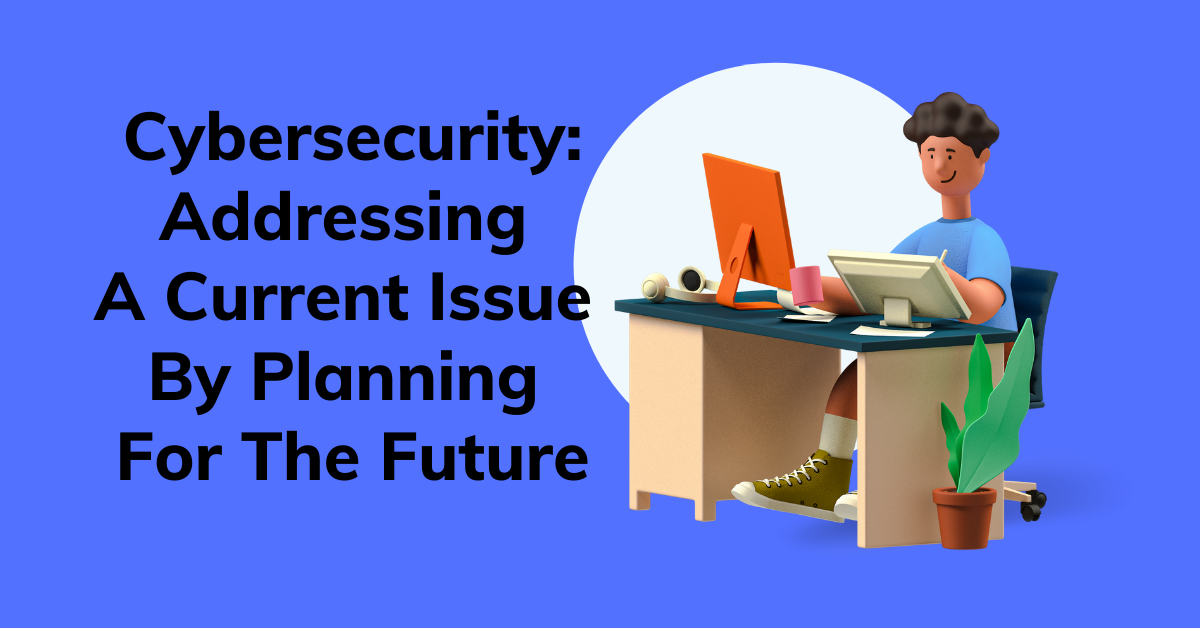If you want to ensure Cybersecurity planning for the future, this post is for you.
In the early 2000s, Cybersecurity did not mean anything and played no significant role in the IT industry. However, the current 4G internet revolution has drastically altered the game. A few years ago, network security was not for regular internet users but for everyday internet users and national security in today's scenario.
If you look at the trend, you can see how frequently cyber-attacks have occurred recently; reports say there will be nearly 1.16 million cyber-attacks in 2020. IT experts say it is almost three times the number recorded in the previous two years, who claim a 20-fold increase since 2016. According to the data, over 3,137 cybersecurity-related concerns are reported every day.
Cyber-attacks are unauthorized activities by cybercriminals who use one or more computers to steal data from other computers on a network. A cyber assault can deliberately turn off systems, steal data, or utilize a compromised computer as a launchpad for additional attacks.
Because everything today is available online, cybercriminals can attack any sector or form. Software AG in 2020 Sopra Steria Ransomware Attack, Telegram Hijack, Seyfarth Shaw Ransomware Attack Carnival Corporation is the victim of a malware attack.
Many other non-IT firms, such as JBS McDonald's, are victims of ransomware cyberattacks. Experts anticipate that the number of ransomware assaults in 2021 may reach 100,000, with each one costing firms an average of $170,000. Exposure to Data Cybercriminals may also cause chaos in large corporations, institutions, the research industry, and even governments using the information they possess.
On July 2, 2021, the REvil ransomware brand acquired a cyber-attack on Kaseya Virtual System/Server Administrator (VSA). Kaseya clients utilize the VSA software to remotely monitor and manage software and network infrastructure. Kaseya offers it as a hosted cloud service or through on-premises VSA servers.
This hack now affects around 1,500 middleware firms, and the company is working diligently to resolve it as quickly as possible. It also stated that there were approximately 5,000 attack attempts in 22 nations at that time.
Cybersecurity refers to the department with total legal control for safeguarding computer data, services, and devices and the ability to detect and prosecute hackers. It relates to the security of technology or the safety of internet data. The word is used in several situations, ranging from business to mobile computing, and may be classified into a few general categories.
Cybersecurity was first executed in the late 1970s to safeguard against hazardous cyberattacks and criminals. Reaper was the first antivirus software and the first self-replicating malware that affected every machine.
READ ALSO: A Step-by-Step Guide To Website Development
Before we talk about Cybersecurity planning for the future, let us address the most pressing problem of Cybersecurity.
Table of Contents
The Most Pressing Problem Of Cybersecurity
The most critical and challenging security aspect is developing the necessary abilities to guard against hackers. As every field seeks a digital platform, cybersecurity has become one of the most pressing concerns in our daily routine.
Last year, the worldwide cybersecurity industry invested approximately $42 billion. The problem is that there aren't enough professionals with the essential abilities to safeguard cyberspace. According to the Global Information Security Workforce, there will be a 2-million-person shortage.
This report suggests that today's younger people can contribute more to closing the global cyber skills gap by undergoing cybersecurity training at the initial stages of their careers.
Contemporary Cyber-educational Concern
Cybersecurity is in limited supply since no adequate education framework exists. The most difficult challenge is how students employ their powers; there is a significant possibility that they may go towards the dark side with these abilities.
Pursuing such a high-risk talent requires good intentions, and educators, companies, or anybody who employs them must closely eye every activity they undertake. That way, they can mitigate against unforeseen cyber threats by ensuring Cybersecurity planning for the future.
When it comes to the learning process, the emphasis should be on experiential learning or learning by doing. Many teachers place a premium on instilling information in their students.
Cybersecurity as a complex technology is a myth; the reality involves students having a proper understanding of the fundamentals of handling advanced safeguards associated with data security.
READ ALSO: How To Fix iPhone Overheating Problem: 6 Easy Steps
AI Cybersecurity And Enhanced Password Protection
Artificial intelligence (AI) is a new hope, and technological advancements are seeking to deliver safer security solutions for all organizations to continuously analyze firms that use AI to provide strict security standards.
The AI innovations constantly study your device and attempt to find the loopholes that hackers exploit to get access. It also flags weak points such as out-of-date devices or weak passwords. This technology may aid in lowering the danger of cyberattacks.
AI technology is a step ahead of standard password protection. It focuses on the user's password, tracks a user's usual log-in location and time of activity, and closely monitors the user's actions, such as usage and typing speed.
This invention entirely replicates human thinking. The substitution of alternative authentication for passwords suggests that the feature security procedures may be in the technology sector.
Cyberattacks and data breaches continue to increase, resulting in a flurry of new technology that tries reinventing current cybersecurity procedures.
As the internet and technology advance, so do the number of attacks and breaches; thus, understanding Cybersecurity is critical in obtaining the proper protection and maintaining data security.
Current Challenges Confronted By Cybersecurity
The digital age has ushered in a golden era of innovation and connection. But with every convenience comes a lurking shadow: the ever-present threat of cyberattacks. As technology advances, so do the tactics of cybercriminals, forcing cybersecurity professionals to adapt and innovate constantly.
Here's a glimpse into some of the most pressing challenges currently confronting the Cybersecurity planning for the future:
1. The Rise of the Machines: Evolving Malware and AI-powered Attacks
Challenge: Malware is no longer confined to clunky viruses. Today, we face sophisticated threats like ransomware, which encrypts a user's data and demands a ransom for decryption. Additionally, Artificial Intelligence (AI) is being weaponized by attackers, creating self-learning malware that can adapt and evade traditional defences.
Impact: These advanced threats can cripple businesses, leading to financial losses, operational disruptions, and reputational damage. Individuals can also fall victim to data breaches, identity theft, and financial fraud.
2. The Expanding Attack Surface: The Internet of Things (IoT) and the Cloud
Challenge: The proliferation of internet-connected devices, from smart home appliances to industrial control systems, creates a vast “attack surface” for vulnerabilities. Additionally, the increasing reliance on cloud computing introduces new security concerns as sensitive data migrates to shared environments.
Impact: A single compromised device in an interconnected system can create a domino effect, leading to widespread disruption. Cloud breaches can expose vast amounts of data, impacting millions of users.
READ ALSO: Mobile Payment Security Concerns – Four Big Things To Consider
3. The Human Factor: Social Engineering and Phishing Attacks
Challenge: Despite advancements in technology, the human element remains a critical vulnerability. Social engineering tactics exploit emotions, trust, and urgency to manipulate users into revealing sensitive information or clicking malicious links. Phishing emails, often disguised as legitimate sources, are a prime example.
Impact: Social engineering attacks can bypass even the most robust technical defences. They can result in financial losses, data breaches, and the compromise of entire systems.
4. The Evolving Regulatory Landscape: Data Privacy Concerns
Challenge: As data collection practices become more pervasive, concerns about user privacy are mounting. Governments around the world are enacting stricter data privacy regulations, forcing businesses to adapt their data handling practices.
Impact: Non-compliance with data privacy regulations can lead to hefty fines and reputational damage. Companies need to stay updated on evolving regulations and implement robust data security measures.
5. The Global Threat Landscape: The Rise of Cybercrime as a Service (CaaS)
Challenge: Cybercrime is becoming increasingly commoditized. Cybercrime-as-a-Service (CaaS) offers hacking tools and expertise to anyone willing to pay, democratizing cyberattacks and making them more accessible to even low-skilled criminals.
Impact: CaaS lowers the barrier to entry for cybercrime, potentially leading to a surge in attacks and making it harder for organizations to defend themselves.
These are just some of the significant challenges confronting Cybersecurity today. By staying informed, prioritizing security best practices, and fostering a culture of cybersecurity awareness, we can work together to create a more secure digital future.
READ ALSO: The Biggest Challenges And Opportunities Facing Tech Businesses Right Now
Conclusion – Cyberbersecurity Planning For The Future
Authorities claim that there is a significant gap between the demand and available resources to address primary and hazardous cyber problems in the years ahead.
Serious training and the current workforce solve some of the problems, but the problem persists in the long run. In the future, the practical education of the younger generation may be the only solution.
Cybersecurity will be one of the top issues for every business, as executives understand the relevance of corporate operations and processes—sophisticated measures like building a firewall to add an extra security layer help to protect against cyber threats.
We must continue to adapt and take cyber risks seriously by planning, preparing, and educating. Open communication between businesses, lawmakers, and regulators is critical to success.
Which cybersecurity planning for the future will you consider? Leave us a comment below.
INTERESTING POSTS
- Why Is Cybersecurity In Financial Services Important?
- Top Cybersecurity Trends Every Web Developer Should Expect In 2020
- Cybersecurity Trends To Know In 2020 (With Infographics)
- Top 5 DDoS Attack Challenges For Telecom Companies
- AS Roma enters partnership with Acronis for Cybersecurity
- COVID-19: How To Stay Ahead During The Slow Season
- Exclusive Interview with SpyCloud's CEO and Co-Founder Ted Ross
About the Author:
Christian Schmitz is a professional journalist and editor at SecureBlitz.com. He has a keen eye for the ever-changing cybersecurity industry and is passionate about spreading awareness of the industry's latest trends. Before joining SecureBlitz, Christian worked as a journalist for a local community newspaper in Nuremberg. Through his years of experience, Christian has developed a sharp eye for detail, an acute understanding of the cybersecurity industry, and an unwavering commitment to delivering accurate and up-to-date information.









